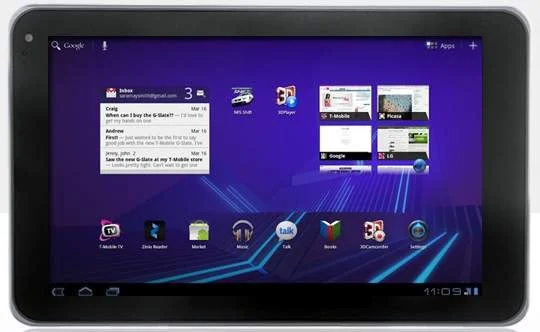It seems as if Google’s half-baked Honeycomb OS is hobbling T-Mobile’s G-Slate tablet, which is due to hit the streets on Wednesday, April 20th.
Yes, the 4G device boasts some pretty tricked-out specs, such as a powerful Tegra 2 processor, a beautiful HD screen, dual-facing cameras, long battery life and 3D video capabilities (glasses included).
Unfortunately, various reviews of the device confirm that Flash 10.2 (beta) is quite buggy, with the unit prone to the occasional reboot when set to idle mode.

In addition, PC Mag confirms a “strange, off-center orientation” for the front-facing camera, while BGR’s Zach Epstein calls the lack of apps a valid, rather than superficial concern.
“Apps, apps, apps. UI design used to be the infantry in the smartphone platform wars, but now applications find themselves on the front lines,” says Epstein.
“For a platform to succeed it must have a solid developer ecosystem and an abundance of apps, pundits repeat ad nauseam. For Honeycomb, this is a problem [and] compared to almost 85,000 iPad apps, this is not promising for those who believe apps make or break a tablet experience.”
Esptein also harshly criticizes the G-Slate’s UI, noting it’s simply “pathetic” for a device with a dual-core 1GHz Tegra 2 processor to suffer from such a “sluggish” interface.
“There are many areas of the OS where touch response is acceptable, but these areas are beyond overshadowed by the bogging and sluggishness in problem areas and in some third-party apps.
“I am not implying that this version of the Android OS is a poor effort on Google’s part, I’m simply stating that it seems like a rushed effort intended to tide us over while Google prepares to put its best foot forward, as it had no choice but to bring Honeycomb to market with haste.”
And therein lies the problem. It is quite clear to me that the market desperately needs a viable alternative to Apple’s iOS.
Consumers like choice and competition can help spur innovation between rival companies, which ultimately ends up benefiting all of us.
But the current situation is untenable, because Google has dropped the ball with Android Honeycomb, and dropped it hard. Now, maybe Google can blame market pressure, but in the end, the reason is irrelevant.
Mountain View must get its act together ASAP. It just simply isn’t fair to vendors, manufacturers or OEMs.
For example, think of this debacle from Nvidia’s perspective.
The Tegra 2 is a powerful chip and it is outrageous that a half-baked UI is dragging performance down. I mean, Nvidia did its job right, why can’t Google?
And the same goes for LG’s hard work and effort. I seriously doubt the abrupt reboot issue is caused by faulty LG hardware. More likely it is an Android Honeycomb UI issue related to poor or sloppy coding.
But what a pity. First Motorola’s Xoom and now T-Mobile’s G-Slate. Seriously, how many more Honeycomb tablets have to fail before Google takes responsibility and stops acting like an immature, condescending start- up?
No, the market will not wait for Google. ARM architecture is certainly quite versatile and more than capable of running multiple operating systems – including Windows 8.






